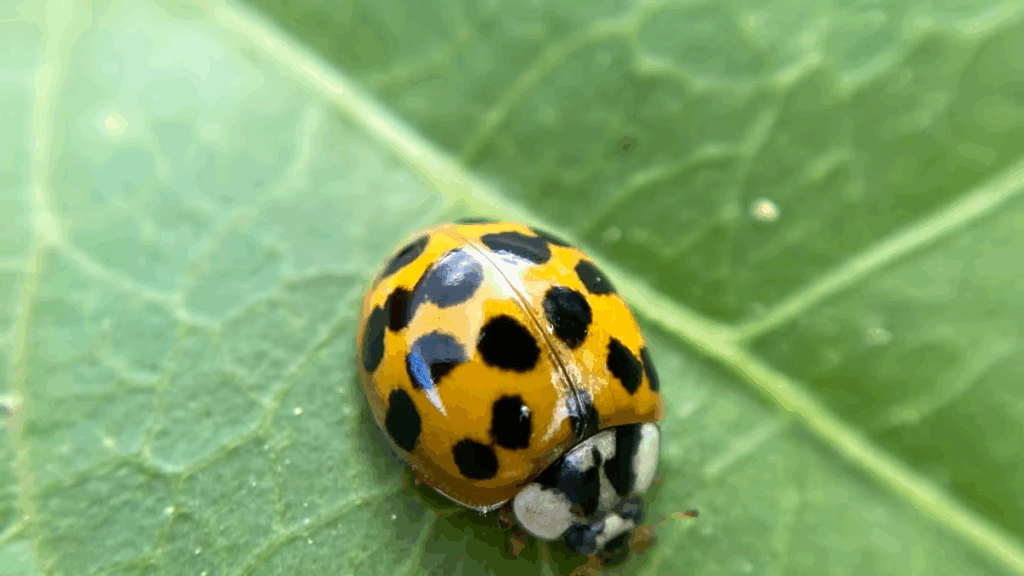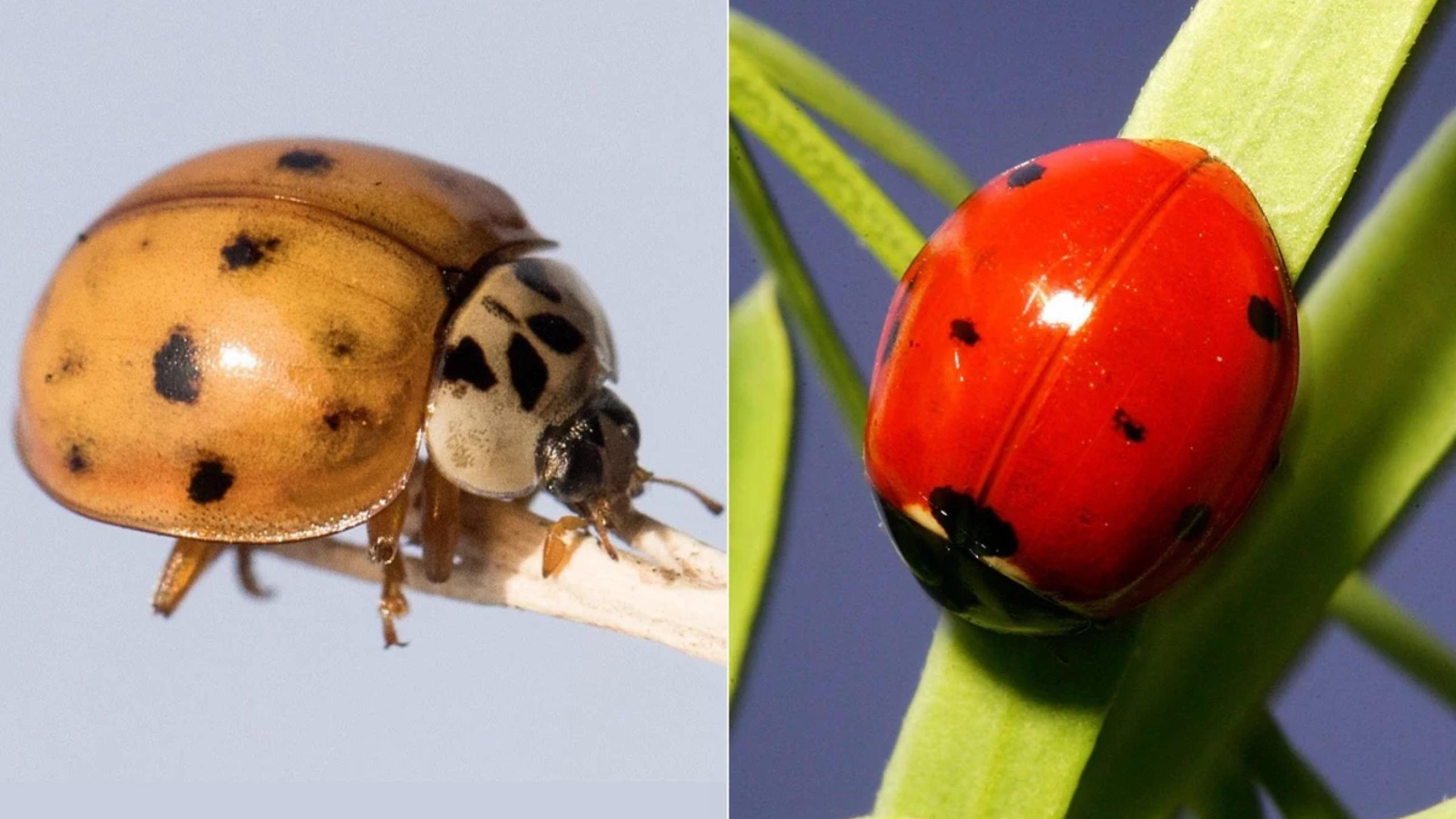At first glance, ladybugs and Asian beetles might seem like similar creatures, both with their small, colorful bodies and familiar spots. However, there’s one major difference—while ladybugs are your garden’s best friend, Asian beetles can become a troublesome pest. By learning to spot the differences between the two, you can ensure that you’re welcoming the helpful ones while keeping the harmful ones at bay.
In this guide, we’ll walk you through the key features and behaviors to help you identify these two insects, so you can protect your plants and your home.
1️⃣ Look at the Color: Red vs. Orange
One of the easiest ways to tell a ladybug from an Asian beetle is by their color. While both insects are typically brightly colored, ladybugs are usually a vibrant red. In contrast, Asian beetles tend to have a more orange hue.
Tip: If the insect you’re looking at is a deeper shade of red, it’s likely a ladybug. If it has a more orange appearance, you’re likely looking at an Asian beetle.
2️⃣ Check the Spots: Neat vs. Messy
Ladybugs are known for their neat, symmetrical black spots. These spots are typically evenly spaced across their red wings, creating a clean and organized appearance.
On the other hand, Asian beetles may have a mix of spots—or none at all—and these spots often appear irregular and scattered. The spots may be difficult to spot due to their inconsistent pattern.
Tip: A ladybug will have clear, uniform spots, while Asian beetles’ spots tend to be irregular, sometimes few or completely absent.
3️⃣ Flip Them Over: Black vs. Yellow-Brown Underside

Another simple way to identify these two insects is by flipping them over. Ladybugs have a black underside with no markings or a few small spots. This dark belly is one of the defining characteristics of a ladybug.
Asian beetles, however, have a yellow-brown underside, which can be quite different from the ladybug’s black belly.
Tip: If you’re able to gently flip the insect, the difference in color on the underside is a clear giveaway.
4️⃣ Watch Their Behavior: Good Guys vs. Bad Guys
Ladybugs are natural pest controllers, and you’ll typically find them outdoors where they help protect your plants by eating harmful pests like aphids. They are beneficial to your garden, and they don’t cause damage to your home.
In contrast, Asian beetles tend to be more aggressive. They bite when threatened, and some people find their scent unpleasant. These beetles also have a tendency to invade homes, especially in the fall when they seek shelter for the winter.
Tip: Ladybugs will stay in your garden, helping control pests, while Asian beetles often enter your home and can become a nuisance.
5️⃣ Notice the “M” Shape: Look at the Head
One of the most unique features of the Asian beetle is the black “M” or “W” shape on its head. This distinctive marking can help differentiate it from a ladybug, which does not have this feature.
Tip: If you spot a black “M” or “W” shape on the insect’s head, you’re most likely dealing with an Asian beetle.
6️⃣ Why Identifying These Insects Matters
While ladybugs are beneficial for your garden, helping to keep harmful insect populations in check, Asian beetles can do more harm than good. These beetles are known to damage plants and even fruit crops by feeding on them. Moreover, when they swarm into homes, they can become a major inconvenience.
By learning to identify these two insects, you can ensure that you’re allowing ladybugs to do their valuable work while keeping the pests out of your home and garden. Knowing the difference can make all the difference for maintaining a healthy, thriving garden and preventing a household invasion.
Common Questions and Answers:
1. Can ladybugs bite?
Ladybugs generally do not bite humans, although they may occasionally nip if they feel threatened. However, their bites are not harmful and rarely cause any issues.
2. Are Asian beetles harmful to plants?
Yes, Asian beetles can damage plants, especially during the larvae stage when they feed on leaves. While adult Asian beetles prefer to eat aphids and other pests, they may also target crops and ornamentals.
3. How do I prevent Asian beetles from entering my home?
To keep Asian beetles from invading your home, seal cracks around windows, doors, and vents. You can also use natural deterrents like citronella, garlic, or diatomaceous earth around your home’s exterior.
4. What should I do if I find an Asian beetle in my garden?
If you find an Asian beetle in your garden, consider removing it gently or using non-toxic traps to prevent them from damaging your plants. Always aim to keep your garden healthy by attracting more ladybugs with plants that encourage beneficial insects.
Conclusion: Spotting the Difference for a Healthier Garden
Learning how to identify ladybugs and Asian beetles is key to maintaining a healthy garden. While ladybugs are your garden’s natural allies, helping to protect your plants from harmful pests, Asian beetles can become a nuisance if not managed. By keeping a close eye on the color, spots, behavior, and markings of these insects, you can ensure that your garden remains pest-free and your home stays safe from unwanted invaders.
So, the next time you spot one of these small creatures in your garden, remember these tips to identify whether it’s a helpful ladybug or a troublesome Asian beetle. Protecting your plants and home has never been easier! 🌿🐞


buy cheap generic amoxicillin – purchase amoxicillin online amoxil pills
buy forcan paypal – https://gpdifluca.com/# order forcan pill
buy cenforce pills – cenforce rs buy cenforce 100mg sale
how to get cialis prescription online – https://ciltadgn.com/# cheap t jet 60 cialis online
tadalafil cialis – this where to buy cialis cheap
ranitidine without prescription – zantac 300mg brand ranitidine online
viagra 100 mg – site buy viagra in dubai
More posts like this would bring about the blogosphere more useful. https://gnolvade.com/es/prednisona/
More articles like this would frame the blogosphere richer. prednisone 20 mg cost
This website absolutely has all of the bumf and facts I needed adjacent to this thesis and didn’t comprehend who to ask. ursxdol
More posts like this would add up to the online play more useful. https://prohnrg.com/product/rosuvastatin-for-sale/
This is the amicable of content I enjoy reading. https://aranitidine.com/fr/clenbuterol/
This is the big-hearted of criticism I in fact appreciate. https://ondactone.com/spironolactone/
With thanks. Loads of expertise!
https://proisotrepl.com/product/methotrexate/
More posts like this would persuade the online play more useful. http://anja.pf-control.de/Musik-Wellness/member.php?action=profile&uid=4709
buy generic forxiga – https://janozin.com/# forxiga 10 mg over the counter
order xenical without prescription – https://asacostat.com/ order xenical 60mg sale
You can keep yourself and your stock by way of being wary when buying pharmaceutical online. Some druggist’s websites operate legally and provide convenience, solitariness, bring in savings and safeguards over the extent of purchasing medicines. buy in TerbinaPharmacy https://terbinafines.com/product/crestor.html crestor
The thoroughness in this draft is noteworthy. ezetimibe ca
This is a keynote which is virtually to my verve… Numberless thanks! Quite where can I lay one’s hands on the phone details in the course of questions?
612214 137658Hi there, i just thought i would publish and now let you know your internet sites style is actually smudged within the K-Melon browser. Anyhow maintain within the very very good work. 819249